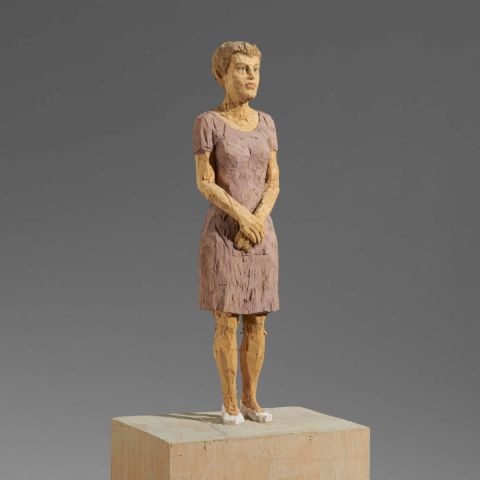
Lot 51 | Bridget Louise Riley | Untitled (Work Drawing)
1931 London
Title: Untitled (Work Drawing).
Date: 1964/65.
Technique: Gouache and drawing on cardboard G-W No. I.
Measurement: 71.5 x 54.5cm.
Notation: Inscribed upper right: Bridget Riley. Additionally inscribed verso: James Fitzsimmons.
This work is a printing plate for a lithograph. It was used for the cover of Art International, Vol. IX, 1965 (Fig. 1). The motif was also selected for the exhibition poster of the Richard Feigen Gallery, New York, where Bridget Riley had an exhibition in 1965 (Fig. 2).
We thank the Bridget Riley Archive, London, for their kind scholarly advice and art historical contextualization of the work. As it is a printing plate, it will not be assigned an archive number.
Provenance:
- James Fitzsimmons, New York
- Hans-Jürgen Müller, Stuttgart
- Private Collection, Northern Germany
- Characteristic, high-contrast gouache by the great British Op Art artist
- Her black and white line paintings from the 1960s are among her most sought-after works
- Riley achieved international recognition in 1965 through her participation in the groundbreaking exhibition "The Responsive Eye" at MoMA in New York
Paths to Op Art
Bridget Louise Riley, born in London in 1931, studied at Goldsmiths College from 1949 to 1952 and then at the Royal College of Art in London until 1955. Her early works were pointillist, inspired by Georges Seurat, before she began to focus intensively on optical phenomena and processes of perception in the early 1960s. In 1961, she finally broke away from representational painting, a step that radically renewed her artistic language: Using a reduced, precisely calculated formal language of lines, curves, circles, and triangles, Riley explored the laws of rhythm, movement, and perception. Her art was the result of planning and calculation, forming a conscious contrast to the clichéd ideal of spontaneous artistic genius.
1965 - The beginning of an international success story
The year 1965 marks the artist's international breakthrough. Her participation in the legendary exhibition “The Responsive Eye” at the Museum of Modern Art in New York, curated by William C. Seitz, which showcases the most important representatives of the Op Art movement, makes her world-famous overnight. In the same year, she had a solo exhibition at the Richard Feigen Gallery in New York, where the motif of the work presented here adorned the exhibition poster. At the same time, it became the cover of the February issue of the magazine “Art International.” That year, Riley's art, and especially her formal language, became the focus of commercial attention: advertisements and shop windows played with the aesthetics of her works and plagiarized them extensively. Thus, “Untitled” is not only a key work in Riley's oeuvre, but also a symbol of the moment when her art became a cultural phenomenon.
Until 1967, Riley worked exclusively in black and white. Only then did she turn to color, without abandoning the strict systematics of her pictorial constructions. In 1968, Bridget Riley represented Great Britain at the Venice Biennale and became the first woman to be awarded the prize for painting.
An attack on viewing habits
The composition consists of a series of closely spaced, parallel curves in black and white. The lines appear to arch over an invisible surface, creating the impression of an oscillating space. When viewing the work, a fluid interplay of movement and counter-movement emerges. This visual instability, which simultaneously captivates and irritates the viewer, forms the core of Riley's oeuvre. The viewer thus becomes an active participant, accomplice, and witness in an optical experiment that challenges and destabilizes perception. With its parallel wavy lines, the work presented here is part of a series of prominent works such as “Fall” from 1963, which is part of the Tate Britain collection, and ‘Current’ from 1964, which was selected for the cover of the catalog for the exhibition “The Responsive Eye.” Fine traces of abrasion and adhesive residue on the unpainted edges of the work are exciting evidence of the working process involved in producing the lithograph for which this work was used as a template.
The untitled work from 1965 condenses the essential elements of Riley's art: intellectual precision and a fascinating interplay between work and perception. The seemingly simple lines unfold an immediate, physically perceptible movement that sets the eye in motion. A work that does not stand still, but comes to life as soon as it is viewed.
Sophie Ballermann
Print this lot | Recommend lot |
Conditions of this Lot
32% buyer’s premium on the hammer price
Estimated shipping costs for this lot:
Arrangement after the auction.
Bridget Louise Riley Post War 1960s Line Works on paper Gouache Abstract





